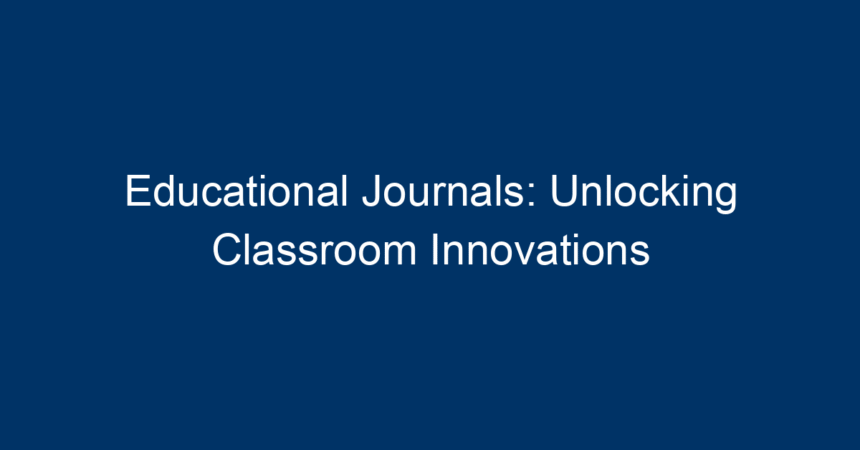In today’s rapidly evolving educational landscape, the need for innovative teaching methods and learning strategies is more crucial than ever. Enter educational journals—vital platforms where educators, researchers, and thought leaders share insights, research findings, and innovative practices. These journals not only enrich classroom practices but also empower educators to enhance student learning in meaningful ways.
This article will explore the significance of educational journals in fostering classroom innovations, highlight the benefits they offer, and provide actionable insights for educators looking to leverage these resources for improved teaching and learning outcomes.
Understanding Educational Journals
What Are Educational Journals?
Educational journals are periodical publications that focus on research, theory, and practice related to education. They serve as repositories for scholarly articles, research studies, case studies, and reviews that explore various aspects of the educational field. The aim is to disseminate knowledge, provide evidence-based practices, and stimulate dialogue among educators.
Importance of Educational Journals
Educational journals play a fundamental role in professional development. They enable educators to stay informed about the latest trends, challenges, and research findings in the field of education. By engaging with these publications, educators can enhance their teaching strategies and better address the diverse needs of their students.
The Role of Educational Journals in Classroom Innovations
1. Sharing Best Practices
Educational journals often highlight successful case studies and innovative teaching methods. These articles serve as valuable resources for educators seeking to implement effective strategies in their classrooms. For instance, a journal article may detail a flipped classroom approach where traditional learning paradigms are upended. By incorporating such practices into their own teaching, educators can better engage students and foster a more interactive learning environment.
2. Bridging Theory and Practice
One of the standout features of educational journals is their ability to bridge the gap between theory and practice. Many journals feature empirical research that examines the effectiveness of educational theories in real classroom settings. This evidence-based approach helps educators apply theoretical frameworks in their daily teaching practices, thereby improving educational outcomes.
3. Stimulating Collaboration
Educational journals often encourage collaboration among educators. Many articles invite input from teachers across different disciplines and geographical locations, promoting an exchange of ideas and resources. This collaborative spirit fosters a sense of community among educators who can share challenges and solutions, leading to further innovations in teaching.
4. Fostering Critical Thinking
By engaging with educational journals, educators develop critical thinking and analytical skills. As they read through studies and research findings, they learn to question methodologies, analyze results, and reflect upon their implications for practice. This cultivates a culture of inquiry within the classroom, encouraging students to think critically and develop their perspectives.
Exploring Types of Educational Journals
1. Peer-Reviewed Journals
Peer-reviewed educational journals are considered the gold standard in academic publishing. Articles within these journals undergo a rigorous review process by experts in the field, ensuring high-quality research and writing. Examples include the Journal of Educational Psychology and the American Educational Research Journal.
2. Practitioner Journals
These journals focus on practical applications and innovations in the classroom. They often feature articles written by educators for educators, sharing firsthand experiences and actionable strategies. Examples include The Educational Forum and Teaching Exceptional Children.
3. Online and Open Access Journals
The rise of digital publishing has led to the proliferation of online and open-access educational journals. These platforms make research more accessible to educators around the globe, breaking down barriers related to subscription fees. Examples include Education Research International and Open Learning: The Journal of Open, Distance and e-Learning.
How to Leverage Educational Journals for Classroom Innovation
1. Identify Relevant Journals
Begin by identifying educational journals that align with your teaching interests and specialties. Make a list of journals that provide research, articles, and case studies pertinent to your curriculum.
2. Regular Reading Habit
Set aside time each week or month to read articles from these journals. Establishing a regular reading habit will keep you informed about the latest trends and practices in education.
3. Apply Insights in the Classroom
After reading, consider how the insights gained from these articles can be applied to your teaching practice. Experiment with new strategies and methodologies, and make adjustments based on feedback and student outcomes.
4. Engage with Professional Learning Communities
Participate in professional networks or social media groups focused on educational journals. Engaging with like-minded educators can foster discussions about innovative practices and enhance collective learning.
5. Contribute Your Knowledge
Consider contributing to educational journals with your research findings or successful teaching practices. Sharing your insights can make a significant impact on the wider educational community.
Challenges in Engaging with Educational Journals
1. Information Overload
With the vast number of educational journals available, it can be overwhelming to sift through the content. To combat this, focus on a select few publications that resonate the most with your teaching practices.
2. Keeping Current
The pace of educational research can be fast. Staying current may require significant time and effort. Setting up alerts for new publications or subscribing to newsletters can help streamline this process.
3. Access Limitations
While many journals are available online, some may require subscriptions. Look for open-access journals and institutional subscriptions that can provide access without personal costs.
Conclusion: Transforming Education Through Educational Journals
Educational journals are much more than just collections of articles; they are powerful tools that can unlock innovations in the classroom. By sharing research findings, best practices, and scholarly discussions, these journals promote a culture of continuous learning and improvement among educators.
To harness the full potential of educational journals, educators must commit to regular engagement with these resources. By applying insights gained, sharing knowledge, and exploring new methodologies, teachers can transform their classrooms into vibrant learning communities.
In a world where the demands of education are constantly evolving, let educational journals be your guide. Embrace the wealth of knowledge they offer, and watch as your teaching transforms, ultimately fostering a richer, more dynamic educational experience for your students.
By integrating the insights and resources available in educational journals, educators can pave the way for an inspiring and effective classroom that meets the diverse needs of all learners. Make the commitment to engage with these publications and unlock the potential for innovation in your educational practices today!




